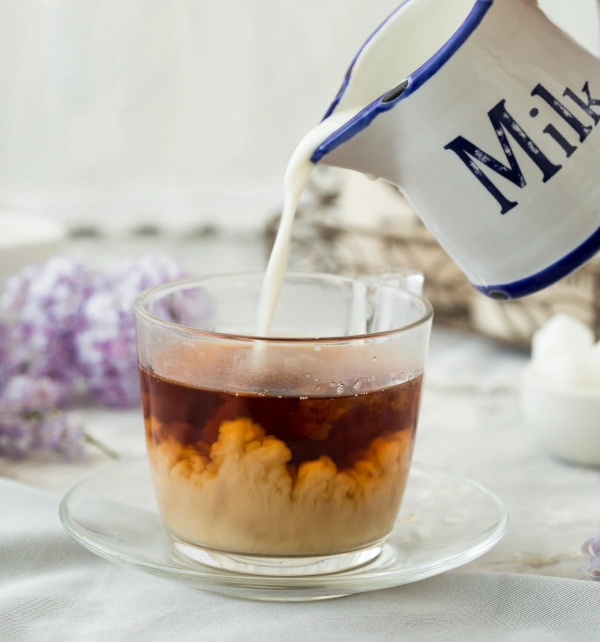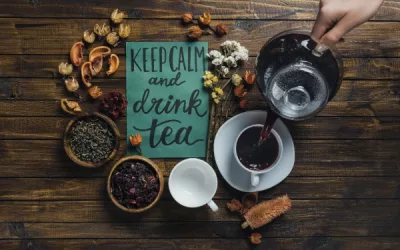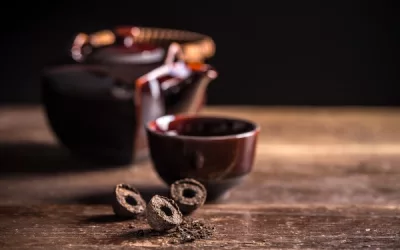Did you know that a cup of tea can vary vastly in calories depending on what you add? For tea lovers and health-conscious individuals alike, understanding the calorie content of tea with milk is essential for making informed choices. This guide will explore everything you need to know, from the calories in different types of milk to practical tips for cutting down on calories. Get ready to uncover the secret behind your favourite brew while ensuring it aligns with your health goals!
Table of Content
- What is the calorie content of tea with different types of milk?
- 1. Tea with Whole Milk:
- 2. Tea with 2% Milk:
- 3. Tea with 1% Milk:
- 4. Tea with Skim Milk (Fat-Free):
- 5. Tea with Almond Milk:
- 6. Tea with Soy Milk:
- 7. Tea with Oat Milk:
- 8. Tea with Coconut Milk:
- Caloric Content of Teas
- How many calories are in tea with whole milk?
- What is the calorie difference between skimmed and whole milk in tea?
- Does adding sugar to tea significantly increase its calories?
- How do serving sizes impact calorie counts in tea with milk?
- What are the healthiest milk options for tea?
- How can I reduce calories in my tea with milk?
- Does adding milk to tea lower its health benefits?
- How do the calories in tea with milk compare to coffee with milk?
- What are some popular recipes for tea with milk?
- How can I track my calorie intake from tea with milk?
- Conclusion
What is the calorie content of tea with different types of milk?
Tea is a popular beverage enjoyed by many across the world. When it comes to counting calories, the type of milk used in tea can make a significant difference. Let’s dive into the calorie content of tea when combined with various types of milk such as whole milk, semi-skimmed milk, skimmed milk, almond milk, and oat milk.
Understanding the calorie content of your tea can help you make better choices if you’re aiming to manage your calorie intake. Different types of milk contribute different amounts of calories to your cup of tea, and knowing these differences can be quite enlightening.
| Type of Milk | Calories (30 ml / ~1 oz) | Total calories with plain Tea (0 kcal) | Total calories with Chai Tea (~50 kcal) | Total calories with Herbal Tea (0 kcal) | Total calories with Fruit Tea (0 kcal) |
|---|---|---|---|---|---|
| Whole Milk | 19 kcal | 19 kcal | 69 kcal | 19 kcal | 19 kcal |
| Semi-Skimmed Milk (2%) | 15 kcal | 15 kcal | 65 kcal | 15 kcal | 15 kcal |
| 1% Milk | 10 kcal | 10 kcal | 60 kcal | 10 kcal | 10 kcal |
| Skimmed Milk (Fat-Free) | 5 kcal | 5 kcal | 55 kcal | 5 kcal | 5 kcal |
| Unsweetened Almond Milk | 4 kcal | 4 kcal | 54 kcal | 4 kcal | 4 kcal |
| Sweetened Almond Milk | 12 kcal | 12 kcal | 62 kcal | 12 kcal | 12 kcal |
| Unsweetened Soy Milk | 8 kcal | 8 kcal | 58 kcal | 8 kcal | 8 kcal |
| Sweetened Soy Milk | 16 kcal | 16 kcal | 66 kcal | 16 kcal | 16 kcal |
| Unsweetened Oat Milk | 8 kcal | 8 kcal | 58 kcal | 8 kcal | 8 kcal |
| Sweetened Oat Milk | 15 kcal | 15 kcal | 65 kcal | 15 kcal | 15 kcal |
| Unsweetened Coconut Milk | 6 kcal | 6 kcal | 56 kcal | 6 kcal | 6 kcal |
| Sweetened Coconut Milk | 12 kcal | 12 kcal | 62 kcal | 12 kcal | 12 kcal |
The calorie content of tea can vary depending on the type and amount of milk added. Here’s a general breakdown of the calorie content for an average 8-ounce cup of tea with different types of milk:
1. Tea with Whole Milk:
- Whole Milk (1 oz or 30 ml): Approximately 19 calories
- Total Calories (Tea + Whole Milk): 19-20 calories
2. Tea with 2% Milk:
- 2% Milk (1 oz or 30 ml): Approximately 15 calories
- Total Calories (Tea + 2% Milk): 15-16 calories
3. Tea with 1% Milk:
- 1% Milk (1 oz or 30 ml): Approximately 10 calories
- Total Calories (Tea + 1% Milk): 10-11 calories
4. Tea with Skim Milk (Fat-Free):
- Skim Milk (1 oz or 30 ml): Approximately 5 calories
- Total Calories (Tea + Skim Milk): 5-6 calories
5. Tea with Almond Milk:
- Unsweetened Almond Milk (1 oz or 30 ml): Approximately 4 calories
- Total Calories (Tea + Unsweetened Almond Milk): 4-5 calories
- Sweetened Almond Milk (1 oz or 30 ml): Approximately 12 calories
- Total Calories (Tea + Sweetened Almond Milk): 12-13 calories
6. Tea with Soy Milk:
- Unsweetened Soy Milk (1 oz or 30 ml): Approximately 8 calories
- Total Calories (Tea + Unsweetened Soy Milk): 8-9 calories
- Sweetened Soy Milk (1 oz or 30 ml): Approximately 16 calories
- Total Calories (Tea + Sweetened Soy Milk): 16-17 calories
7. Tea with Oat Milk:
- Unsweetened Oat Milk (1 oz or 30 ml): Approximately 8 calories
- Total Calories (Tea + Unsweetened Oat Milk): 8-9 calories
- Sweetened Oat Milk (1 oz or 30 ml): Approximately 15 calories
- Total Calories (Tea + Sweetened Oat Milk): 15-16 calories
8. Tea with Coconut Milk:
- Unsweetened Coconut Milk (1 oz or 30 ml): Approximately 6 calories
- Total Calories (Tea + Unsweetened Coconut Milk): 6-7 calories
- Sweetened Coconut Milk (1 oz or 30 ml): Approximately 12 calories
- Total Calories (Tea + Sweetened Coconut Milk): 12-13 calories
Caloric Content of Teas
- Plain Tea: Generally has negligible calories, often cited as 0-2 kcal per cup, supporting the assumption of 0 kcal in the table[1][3].
- Chai Tea: The calorie content varies significantly based on the ingredients, but a typical serving can contain around 50 kcal when made with whole milk and sweeteners, which aligns with your claim[2][4].
- Herbal and Fruit Teas: These are often considered to have negligible calories, typically cited as 0 kcal, supporting the table’s assumptions[1][3].
Notes:
- Sugar: If you add sugar or sweeteners to your tea, it will significantly increase the calorie content. For example, one teaspoon of sugar adds about 16 calories.
- Serving Size: These estimates are based on adding 1 oz (about 30 ml) of milk to an 8-ounce cup of tea. If you use more or less milk, adjust the calorie count accordingly.
Tea itself, when consumed without milk or sweeteners, is virtually calorie-free. The calorie content mainly comes from the type and amount of milk added.
Citations:
- [1] https://www.healthline.com/nutrition/tea-calories
- [2] https://food.ec.europa.eu/safety/labelling-and-nutrition/nutrition-and-health-claims/nutrition-claims_en
How many calories are in tea with whole milk?
When you add whole milk to your tea, you’re looking at a higher calorie count compared to other types of milk. Whole milk has around 150 calories per cup (240 ml). If you use about 30 ml (2 tablespoons) of whole milk in your tea, it adds approximately 19 calories.
- Whole milk: 150 calories per cup (240 ml)
- 30 ml of whole milk: 19 calories
- Rich and creamy texture
- More fat content compared to other milks
Whole milk adds a rich, creamy texture to your tea, but it also comes with higher fat content. This might be a consideration if you’re watching your calorie intake.

What is the calorie difference between skimmed and whole milk in tea?
Skimmed milk is a great alternative if you’re looking to cut down on calories while still enjoying your tea. Skimmed milk has around 80 calories per cup (240 ml). When you add 30 ml of skimmed milk to your tea, it adds approximately 10 calories.
- Skimmed milk: 80 calories per cup (240 ml)
- 30 ml of skimmed milk: 10 calories
- Lighter texture compared to whole milk
- Lower fat content
The calorie difference between skimmed and whole milk in tea is noticeable. Using skimmed milk instead of whole milk can save you around 9 calories per serving.
Does adding sugar to tea significantly increase its calories?
Adding sugar to your tea will increase its calorie content significantly. Each teaspoon of sugar contains about 16 calories. If you prefer your tea sweet, even a couple of teaspoons can add up quickly.
- 1 teaspoon of sugar: 16 calories
- 2 teaspoons of sugar: 32 calories
- Adds sweetness and flavour
- Can be substituted with lower-calorie alternatives like stevia
If you’re trying to manage your calorie intake, you might want to consider sugar substitutes like stevia or other sweeteners that have fewer calories.
In the early 19th century, a British nurse named Florence Nightingale served tea to wounded soldiers. She discovered that adding milk to tea could provide much-needed calories and nutrients to aid in their recovery.
Nightingale’s innovative use of tea with milk helped soldiers regain strength, showcasing how even a simple cup of tea can have a profound impact on health and well-being.
How do serving sizes impact calorie counts in tea with milk?
Understanding how serving sizes affect calorie counts in tea with milk is crucial for managing your daily calorie intake. The calories in tea with milk can vary significantly depending on the type of milk and the amount you add.
Let’s break it down to make it easier to grasp.
When you pay attention to serving sizes, you can better control your calorie consumption. A small cup won’t have the same calorie content as a large mug, and different types of milk can add varying numbers of calories.
For instance, whole milk adds more calories than skimmed milk. So, knowing the calorie count for different serving sizes helps you make informed decisions.
Calorie counts for different serving sizes of tea with various types of milk
Here’s a table to help illustrate the impact of serving sizes on calorie counts when you add various types of milk to your tea:
| Type of Milk | 100ml | 200ml | 300ml |
|---|---|---|---|
| Whole Milk | 64 | 128 | 192 |
| Semi-Skimmed Milk | 48 | 96 | 144 |
| Skimmed Milk | 35 | 70 | 105 |
| Soy Milk | 33 | 66 | 99 |
| Almond Milk | 13 | 26 | 39 |
| Oat Milk | 47 | 94 | 141 |
| Coconut Milk | 19 | 38 | 57 |
To use this table, simply locate the type of milk you add to your tea and match it with the serving size. For instance, if you use 200ml of whole milk, your tea contains 128 calories from the milk alone.
This way, you can easily manage your calorie intake by adjusting the amount and type of milk you use.
Why serving sizes matter
It’s easy to overlook how much milk you’re actually pouring into your tea. But serving sizes matter because they directly influence your calorie intake. Larger servings add more calories, which can add up over time.
- Whole milk has more fat and calories than skimmed milk.
- Plant-based milks, like almond or soy, generally have fewer calories.
- Serving sizes in cups or mugs can vary, affecting calorie intake.
- Tracking serving sizes helps with consistent calorie counting.
- Adjusting milk types can better align with dietary goals.
By being mindful of how much milk you add, you can enjoy your tea while keeping your calorie intake in check. It’s all about finding a balance that works for you.
How to reduce calories in tea with milk
If you’re looking to cut down on calories, there are a few simple tweaks you can make to your tea routine. Switching the type of milk or reducing the quantity can make a significant difference.
- Opt for skimmed or semi-skimmed milk instead of whole milk.
- Try plant-based milks like almond or soy for fewer calories.
- Measure the milk you add to avoid extra calories.
- Consider using sweeteners with fewer calories if you add sugar.
- Explore herbal teas that don’t require milk.
These small adjustments can help you enjoy your tea without compromising your calorie intake. It’s all about making informed choices that suit your health goals.
In the 18th century, tea became a staple beverage in Britain. The tradition of adding milk started when early tea drinkers wanted to cool down their hot tea and protect their delicate porcelain cups from cracking.
The practice caught on, and milk tea became a cultural norm. Interestingly, the British East India Company played a significant role in popularising tea as they imported large quantities from China and later India, making it accessible to the masses.
What are the healthiest milk options for tea?
Let’s dive right into the world of milk choices for your favourite cuppa. Whether you’re a die-hard traditionalist or an adventurous sipper, there’s a milk out there that’s perfect for your tea goals.
From the classic whole milk to the trendy oat milk, each option comes with its own nutritional perks and quirks.
First off, considering whole milk, it adds richness and a creamy texture to your tea. It’s like the comfort food of milk choices but, let’s be honest, it’s not the waistline’s best friend. With around 150 calories per cup, whole milk is heavy on both fat and calories.
If you’re watching your figure, skimmed milk is a worthy contender. Clocking in at about 90 calories per cup, it offers a lighter, less calorie-dense option. It’s like whole milk’s slimmer, health-conscious cousin—smooth but without the fat baggage.
Now, for those of you embracing plant-based lifestyles, almond milk might be your cup of… well, tea. With only about 30 calories per cup, it’s a great low-calorie option that still adds a bit of nutty flavour.
Soy milk steps up the game with around 80 calories per cup. It’s a protein powerhouse compared to other plant-based alternatives, making it more satisfying and somewhat closer to cow’s milk in terms of creaminess.
Lastly, oat milk—everyone’s favourite hipster milk. With about 120 calories per cup, it’s not the lightest, but it’s full of fibre and has a naturally sweet, smooth texture that marries well with tea.
Which milk alternative is the lowest in calories?
So, let’s cut to the chase. If calorie-counting is your jam, you’ll want to pay attention to this bit.
Among all the milk alternatives, almond milk takes the crown with the lowest calorie count, sitting pretty at about 30 calories per cup. It’s ridiculously light yet still manages to enrich your tea with a discreet nutty essence.
- Almond Milk: Around 30 calories per cup.
- Skimmed Milk: Roughly 90 calories per cup.
- Soy Milk: About 80 calories per cup.
- Oat Milk: Approximately 120 calories per cup.
- Whole Milk: Around 150 calories per cup.
Switching to almond milk means you can cut down calories without sacrificing the holistic tea experience. That’s a win-win situation right there.
Are there any health benefits to using non-dairy milk in tea?
Non-dairy milks aren’t just a fad; they come loaded with benefits that go beyond just being animal-friendly. Here are some perks to think about.
- Lower Calories: Generally, plant-based milks like almond or soy contain fewer calories compared to whole or even skimmed milk.
- Lactose-Free: A saviour for those who are lactose intolerant. Enjoy your tea without the dreaded belly bloat.
- Healthy Fats: Especially in almond milk, which contains monounsaturated fats, known for their heart-health benefits.
- High Fibre: Oat milk brings fibre to the table, helping with digestion and adding to your daily fibre intake.
- Reduced Saturated Fats: Non-dairy options typically have lower saturated fat levels compared to dairy milk, contributing to better heart health.
So, in addition to saving some calories, non-dairy options also come packed with other health benefits, making them a solid choice for the health-conscious tea aficionado.
How do different milk types affect the taste of tea?
Taste is subjective, but here’s the lowdown on how these different milk types can change your tea-drinking experience.
- Whole Milk: Adds a deep, creamy texture, making your tea richer and more luxurious.
- Skimmed Milk: Lightens your tea without overwhelming the flavour; a good middle ground.
- Almond Milk: Introduces a subtle nutty undertone. A hit with some, but it can be an acquired taste.
- Soy Milk: Provides a creamy, slightly sweet flavour that’s closer to dairy milk, making it a popular choice.
- Oat Milk: Brings a naturally sweet, smooth texture that compliments the tea without overpowering it.
In essence, your choice of milk can either enhance or slightly alter the taste of your tea. It all boils down to your personal taste buds and dietary preferences.
Believe it or not, long before the current plant-milk craze, there was John Harvey Kellogg. The same chap who invented cornflakes also whipped up nut-based milk alternatives back in the late 19th century!
Kellogg promoted these non-dairy options at his sanitarium for health benefits. You know, right alongside hydrotherapy and electric baths. So, next time you pour almond milk into your tea, give a little nod to good old John Harvey.
He was ahead of his time, pushing the boundaries of culinary health just like we are today.
How can I reduce calories in my tea with milk?
Tea with milk—a classic combo that’s as British as complaining about the weather. Yet, for those keeping a close eye on their waistlines, this creamy delight can be a sneaky calorie culprit. But worry not! I’m here to spill the tea on how you can enjoy your beloved brew without it tipping the scales.
First, let’s tackle the most obvious culprit: that lush, velvety milk. If you’re still dunking whole milk into your cuppa, you might want to rethink. Opt for skimmed, semi-skimmed, or plant-based alternatives like almond, soy, or oat milk.
They don’t pack as many calories but still give you that creamy texture. Also, let’s not forget about portion control. The standard British splash may be tiny, but a heavy-handed pour can add up. Use just enough to coat your tea golden, not beige.
Then there’s sugar. Sweet, sweet sugar. Swap it for a low-calorie sweetener or, better yet, wean yourself off entirely. The natural flavours of tea can actually be quite delightful once your taste buds adjust.
What are some low-calorie sweetener options?
For those with a sweet tooth, the thought of eliminating sugar can feel like a slap in the face. But fret not, there are alternatives that’ll not only keep things sweet but also keep your calorie count in check:
- Stevia: A natural sweetener derived from the Stevia plant. Zero calories, but a bit of an aftertaste. Your mileage may vary.
- Erythritol: Found in fruits like grapes and watermelons. Bulkier than Stevia, and often mixed with it. Minimal aftereffects.
- Monk fruit: Another natural sweetener with zero calories. Sweeter than sugar but without the calorie baggage.
- Artificial sweeteners: Saccharin, aspartame, and sucralose. These have been FDA approved, but long-term effects are still debated.
- Xylitol: A sugar alcohol found in many fruits and vegetables. It has about half the calories of regular sugar but can cause digestive upset in large quantities.
Switching to one of these sweeteners can significantly cut down on calorie intake without depriving your taste buds of joy.
How can I enjoy tea with milk without compromising flavour?
Ah, flavour—it’s what keeps us coming back to those steaming mugs. Reducing calories doesn’t mean you have to sip on sadness:
- Use quality tea: The better the tea, the less you’ll miss the added sugar and heavy milk. Full-bodied teas like Assam or Darjeeling can hold their own.
- Infuse with spices: Add cinnamon, cardamom, or a splash of vanilla extract to amp up the flavour without adding calories.
- Play with plant-based milk: Almond, cashew, and coconut milks each bring their unique flavour profiles. Try them out and pick your favourite.
- Less is more: A strong brew that needs less milk can turn out to be flavourful. Let those tea leaves steep longer to release deeper flavours.
- Temperature control: A well-brewed cup at the right temperature can be more satisfying than you think.
You can still have your cake—erm, tea—and drink it too, all without missing out on the layers of flavour you love.
Are there any recipes for low-calorie tea with milk?
Yes, there are tasty, waist-friendly recipes that will make you forget you’re even making a calorie-conscious choice:
- Almond Milk Chai Latte: Brew some black tea with spices like cinnamon, cardamom, and cloves. Strain and mix with unsweetened almond milk.
- Vanilla Chai: Brew strong black tea and mix in a few drops of vanilla extract. Add a splash of soy milk.
- Matcha Latte: Blend matcha powder with hot water, then mix in warmed oat milk. Add a low-calorie sweetener like Stevia if needed.
- Herbal Coconut Milk Tea: Brew some herbal tea (like rooibos) and mix with light coconut milk.
- Earl Grey with Spices: Brew Earl Grey tea, add a thin slice of ginger, and mix with skimmed milk or an alternative.
You won’t be skipping out on any enjoyment with these recipes, just the extra calories.
Tea enthusiasts, ever heard of Catherine of Braganza? She married Charles II and is credited with popularising tea in England during the 17th century. She was such a tea addict that she influenced the whole nation to pick up the habit.
While we can’t say for sure she counted calories, what’s certain is that tea became an essential British ritual. Think of her as you sip your newly crafted, low-calorie brew—you’re basically royalty!
Does adding milk to tea lower its health benefits?
So, you’re sipping your morning brew, and that creamy splash of milk makes everything right with the world. But then it hits you: “Is this delicious combo ruining my health benefits?” Let’s dive into the nitty-gritty of tea, milk, and all the science-y stuff in between.
Firstly, tea is like the superhero of beverages. Rich in antioxidants, specifically catechins, it’s known to have superpowers like reducing inflammation, fighting off nasty free radicals, and even aiding in weight loss. When you add milk, however, things get a bit complicated. Milk contains casein, a protein that tends to bind with those fabulous antioxidants, potentially neutralising their powers.
Does this mean your beloved tea-milk combo is a villain in disguise? Not necessarily. Several studies suggest the effect isn’t all that dramatic and might depend on factors like the type of tea and amount of milk. But, let’s dig deeper.
What are the health benefits of drinking tea?
Tea isn’t just a soothing, warm cup of happiness; it’s a health-packed dynamo. Here’s why:
- Antioxidants: Tea is loaded with polyphenols, which protect your cells from damage.
- Heart Health: Studies suggest tea might reduce the risk of heart disease and stroke.
- Weight Management: Some teas can boost metabolism and help burn fat.
- Mental Alertness: The caffeine in tea is less than coffee but enough to keep you alert.
- Hydration: Despite the caffeine, tea contributes to your daily fluid intake.
Whether it’s green, black, or oolong, tea has a buffet of benefits. Adding milk doesn’t completely erase these benefits, though it’s good to be aware of the possible diminution in antioxidant absorption.
How does milk interact with the nutrients in tea?
So, what does milk do when it joins the tea party? Here’s the science part:
- Casein Protein: Binds with tea’s catechins (antioxidants), potentially reducing their effectiveness.
- Calcium: Adds a beneficial nutrient to your brew.
- Sugar Content: If you use sweetened milk, your cup might pack an extra calorie punch.
- Flavour Enhancement: For some, milk makes tea more palatable, leading to better adherence to drinking it.
While casein and catechins have this love-hate relationship, it’s not all doom and gloom. Some studies indicate that the interaction might not significantly diminish the overall health benefits you get from your daily tea intake.
Is it healthier to drink tea without milk?
Now comes the million-pound question: Should you kick milk out of your teacup for maximum health benefits? Well, it’s not a black-and-white situation. Let’s weigh it out:
- Maximising Antioxidants: Drinking tea sans milk will ensure you get the most from those catechins.
- Lower Calories: No milk means fewer calories, which is great for those watching their waistline.
- Pure Taste: Experience the true flavours and nuances of your tea.
- Potential Digestive Ease: For those with lactose intolerance, avoiding milk is an obvious win.
However, if you love your tea with a splash of milk, don’t fret. The health hit isn’t enormous, and if it makes the drink more enjoyable, it might actually lead to more tea consumption, along with whatever benefits remain.
Imagine Catherine of Braganza, the Portuguese princess who introduced tea to Britain in the 17th century. Picture her servants boiling the kettle, steeping the leaves, and then – a revolutionary idea – adding milk.
Back then, it was to cool the tea down since porcelain cups were fragile. Little did they know, this little addition would stir up debates centuries later. Frankly, if adding milk was good enough for royalty, you’re in good company.
How do the calories in tea with milk compare to coffee with milk?
When you’re counting calories, every little detail matters—even the milk in your tea or coffee. So, let’s dive into the nitty-gritty details about the caloric showdown between two hot drink staples: tea with milk and coffee with milk.
Generally, both of these delightful beverages undergo a calorie boost when you add milk. But coffee being the rowdy cousin of tea tends to hog more calories. A standard cup of coffee with milk usually contains around 20 calories, which can ramp up fast if you start adding extras like sugar or cream. Tea with milk, however, is a bit of a lightweight, typically clocking in at about 10 calories per cup. Mind you, this can also spike if you decide to transform your humble tea into a sugary, creamy concoction.
So, if you’re looking to shave off those extra calories without sacrificing your hot drink rituals, tea with milk is generally the better option.
Now, let’s glide seamlessly from calorie counts to health perks because who doesn’t like some added benefits with their brew?
Which beverage is generally lower in calories?
Brace yourself for the big reveal: Tea!
It might not come as a shocker, given its less robust nature compared to coffee, but numbers don’t lie. When both beverages stand under the spotlight with milk as a sidekick, tea’s calorie count is lower.
- Tea with skimmed milk: Around 10 calories
- Coffee with skimmed milk: Around 20 calories
- Add sugar: Each teaspoon adds approximately 15 calories
- Full-fat milk: Roughly 20 calories per 30 ml
- Cream: A hefty 53 calories per tablespoon
Before you go decorating your drinks with heaps of sugar or cream, remember that these additions can drastically change the caloric landscape. Stick to skimmed milk for a leaner beverage.
What are the health benefits of tea compared to coffee?
Moving on from calories, let’s chew on some juicy health benefits. Tea, despite being lighter on the calorie radar, packs a punch in other departments.
- Antioxidants: Teas like green and black are loaded with antioxidants.
- Hydration: Tea helps in keeping you hydrated.
- Relaxation: Compounds in tea like L-theanine promote relaxation without drowsiness.
- Heart health: Some studies suggest tea benefits cardiovascular wellness.
- Bone health: Tea can improve bone density.
And coffee isn’t the devil’s drink either:
- Antioxidants: Yup, it’s antioxidant-rich too.
- Metabolism boosters: Caffeine in coffee can rev up your metabolism.
- Liver benefits: Moderate coffee consumption can protect your liver.
- Reduced risk of some cancers: Studies indicate coffee might lower the risk of certain cancers.
- Cognitive function: Lovers of coffee often showcase sharper cognitive abilities.
How does caffeine content vary between tea and coffee?
Let’s not leave out the energising agent that drives most of us to these drinks—caffeine. Here’s how these legendary brews stack up.
- Coffee: Around 95 mg of caffeine per cup
- Black tea: Approximately 47 mg of caffeine per cup
- Green tea: About 28 mg of caffeine per cup
- Decaf coffee: Typically 2-5 mg of caffeine per cup
- Herbal teas: Virtually caffeine-free
It’s clear; coffee is the heavyweight champ, boasting almost double the caffeine of black tea.
So, if you’re aiming for a moderate stimulant that won’t have you jittering like a marionette, tea could be your best buddy. Not to mention, an array of teas can offer you soothing calmness or a gentle boost.
In the grand scheme of things, your choice between tea with milk or coffee with milk depends on your personal parameters—calorie consciousness here, health benefits there, or maybe a desired caffeine kick.
Speaking of caffeine and tales of power, did you know that during the American Revolutionary War, boycotts of British goods included tea due to heavy taxation? Colonists turned to coffee as a patriotic alternative.
This one act eventually shifted America’s preference from tea to coffee. Imagine, historical trends all sparked by some taxation drama! How’s that for a caffeinated twist in history?
What are some popular recipes for tea with milk?
Tea with milk is a beloved combination worldwide, bridging cultures and generations. Whether you’re a die-hard fan of traditional chai or exploring modern twists with plant-based milk, there’s a recipe that suits your taste.
Let’s dive right into some popular ones.
Chai is a classic that warms the soul, no matter the season. Think black tea, milk, sugar, and a medley of spices creating an aromatic delight. Masala tea, on the other hand, amplifies this with more spices for a robust flavour.
For the health-conscious among us, there are lighter, healthier versions that still pack a punch. And, in today’s increasingly health-aware world, modern recipes using milk alternatives have leapt to popularity, combining the creamy texture of milk with new, exciting flavour profiles.
What ingredients are commonly used in chai?
Ingredients in chai can make or break the experience. Luckily, the essentials stay pretty consistent:
- Black Tea: The base for any good chai. Assam or Darjeeling are favourites.
- Milk: Cow’s milk is traditional, but feel free to experiment.
- Sweeteners: Sugar, honey, or even maple syrup can work wonders.
- Spices: Cardamom, cloves, cinnamon, ginger, and sometimes pepper for that extra zing.
- Water: To brew the black tea and meld those spicy flavours together.
With these ingredients, you’ve got the foundation for authentic chai. Now, let’s keep it going with some preparation tips.
Brewing chai involves boiling black tea leaves with spices and water first. As the tantalising aromas fill your kitchen, add milk and sweetener. A key pro tip: let it simmer rather than boil, keeping the flavours balanced without scalding.
How can I make a healthy version of masala tea?
Masala tea can be delicious and not wreck your dietary goals. Here’s how to keep it light:
- Use low-fat or skimmed milk instead of full-fat.
- Opt for natural sweeteners like honey or stevia.
- Cut down on the amount of sweetener you use.
- Add an extra dash of ginger; it’s great for digestion and metabolism.
- Use green tea leaves instead of black for a lighter version.
Ingredients:
- Green tea leaves or a light black tea
- Low-fat or skimmed milk
- Natural sweeteners (honey, stevia, or a small quantity of agave)
- Spices such as ginger, cardamom, cloves, and a dash of turmeric for its anti-inflammatory benefits
- Water
You’re not skimping on flavour, either. Instead, you’re making strategic swaps. Green tea forms a subtler base, letting the spices shine while being gentler on your system.
Are there any unique tea recipes that use milk alternatives?
Absolutely, and they can be a game-changer! Modern milk alternatives are not only lower in calories but also add unique flavours:
- Almond Milk Chai: Light and nutty, perfect for a vegan chai experience.
- Oat Milk Tea: Creamy with a hint of sweetness; it’s like drinking a warm hug.
- Soy Milk Masala Tea: Rich and slightly thicker, giving you a velvety texture.
- Coconut Milk Tea: Exotic and perfect for adding a tropical twist.
Here are the essentials for an Almond Milk Chai:
- Almond milk instead of cow’s milk.
- Black tea or robust herbal tea like rooibos for a caffeine-free version.
- Sweeteners as preferred—maple syrup pairs wonderfully with almond milk.
- Traditional chai spices: cardamom, cinnamon, cloves, and ginger.
- A pinch of nutmeg for that extra oomph.
Switching out traditional milk for almond or oat milk doesn’t complicate the process. Brew your tea and spices as usual, then add your milk alternative. Same process, new twist.
In the 17th century, the British East India Company began importing tea to England, sparking an entire culture around it. Back then, sugar was considered a luxury ingredient. The English discovered that adding milk reduced the tea’s bitterness and made it more palatable.
With this, the classic tea time ritual was born, complete with delicate china and elaborate etiquette. Today, we may not need powdered wigs or bonnets, but our love for tea with milk continues, transcending centuries.
How can I track my calorie intake from tea with milk?
Alright, so you’ve got your steaming cup of tea with a splash of milk. It’s delicious, but you’re also watching those pesky calories. Let’s dive into how you can keep tabs on the calories sneaking into your cup. It’s simpler than you might think, and yes, there’s an app (or five) for that.
First things first, if you plan to track calories, apps are your new best friends. They turn the tedious job of number crunching into a breezy task. Now, don’t you dare think you need a maths degree to calculate your intake. These digital wonders do the legwork for you.
What apps can help me track my calorie intake?
You’re in luck because the tech world has blessed us with numerous apps designed specifically for this purpose. Here’s a cheeky rundown of the top contenders:
- MyFitnessPal: Your calorie-tracking Swiss Army knife. It’s got a database chock-full of foods and drinks, including our beloved tea with milk.
- Lose It!: Perfect for setting calorie goals and watching your intake like a hawk. It even breaks down macro and micronutrients.
- Cronometer: More than just calories. This app dives deep into vitamins, minerals, and everything between.
- Yazio: Sleek interface, user-friendly, and packed with features to help you hit your nutrition goals.
- Calorie Counter by FatSecret: Great for diary keeping and offers a variety of ways to log your calories. Plus, it’s got a barcode scanner to make your life easier.
Each of these apps comes with features that can help log every sip, bite or nibble you take, making the whole tracking ordeal much less of an ordeal.
How can I accurately measure my tea servings?
Alright, so you’ve got your app, but now you need to measure your tea down to the last drop. This doesn’t mean you need a full lab setup. Basic kitchen tools will suffice.
- Measuring Cups: For the tea and milk, measuring cups are a must. They help you get the volume right.
- Digital Scale: Weighing your tea and milk gives you the most accurate calorie count possible.
- Standard Teaspoons/Tablespoons: Useful for sugar or any other add-ins you might use.
- Tea Strength: Remember, stronger tea might need more milk to balance the bitterness, affecting the overall calorie count.
- Label Reading: Check milk labels for calorie information. Even different brands of the same type of milk can vary in calories.
Using these tools ensures that what you log into your calorie-counting app is spot-on, reducing the chances of underestimating your intake.
Are there any tips for keeping a food diary?
Now, food diaries – they might sound old-school but are incredibly effective. Here’s how to make the most of them without wanting to pull your hair out:
- Consistency Is Key: Log your entries right after you consume your tea to ensure nothing is forgotten.
- Be Specific: Note down the exact amount of milk, type, and any sweeteners or additions.
- Track It All: Sometimes, you might have multiple cups. Make sure to track each one and their variations.
- Summarise Daily: At the end of the day, review your entries. It helps in understanding your habits and patterns.
- Honesty: Fudging (no pun intended) the numbers might make you feel better now, but it doesn’t help in the long run.
Keeping a detailed food diary helps you become more aware of what you’re consuming. Plus, it’s quite enlightening to see the patterns in your eating and drinking habits.
Now, let’s sprinkle in some history to sweeten the deal. Back in the day, the likes of George Orwell wrote extensively about tea. In “A Nice Cup of Tea,” Orwell penned down the art of making the perfect brew, proving that tea’s been a beloved beverage for centuries.
Historically, tea was even a symbol of the British resilience during World War II. Tea helped keep morale high, and rationing meant the Brits had to be meticulous with every ounce – somewhat similar to tracking calories if you think about it. So, next time you log a cup, remember, you’re in good company!
Conclusion
As I reflect on the journey through the intricacies of tea with milk and its calorie content, it’s clear that our beverage choices can carry significant weight—both in terms of flavour and nutrition.
From whole milk to almond milk, understanding the calorie profiles of these options reveals just how much each choice impacts our daily intake. It’s not only about knowing that whole milk adds more calories than skimmed; it’s about recognising how such choices can align with our health goals.
The exploration of serving sizes further underscores the importance of mindfulness. A seemingly innocuous cup can drastically vary in calories based on how much we pour. Armed with this awareness and a handy table at our disposal, we can navigate our beverage choices more effectively, ensuring we indulge in our beloved tea while keeping our health in check.
Moreover, the assessment of the healthiest milk alternatives unveils a world of delicious yet lower-calorie options. Whether it’s the creamy comfort of oat milk or the lightness of skimmed milk, each choice not only affects calorie counts but also brings its own set of nutritional benefits. As someone who enjoys the luxurious taste of a well-prepared cup of tea, I’ve found that there are endless ways to make lighter choices without sacrificing enjoyment.
With practical strategies for reducing calorie intake, such as opting for low-calorie sweeteners or experimenting with portion control, I’m reminded that a satisfying cup of tea doesn’t have to entail remorse.
Each small adjustment adds up, allowing us to maintain our enjoyment while being conscious of our consumption.
However, the question lingers: Does adding milk diminish the health benefits of tea? While some may argue that it may interfere with the absorption of certain nutrients, the overall advantages of tea consumption cannot be overlooked.
This calls for a balanced approach—one that allows us to relish our tea rituals while staying aware of the interacting ingredients.
Finally, as we consider our comparative analysis of tea with milk and coffee with milk, it’s striking how the nuances of flavours and health benefits truly shape our preferences. Each beverage offers its own allure and charm, enticing us to choose based on our individual goals.
In closing, let’s not merely sip our tea in haste, but relish in its depth and richness while maintaining a keen eye on our choices. If nothing else, may we continue to find joy in every cup, reflecting on how even the simplest decisions shape our overall well-being.
So, the next time you’re brewing that beloved cup, ponder this: how does what you pour affect not just your palate but your health? In the delightful world of tea, the possibilities are boundless, as is the journey to health consciousness.
Resources
- Coffee and Tea Consumption and the Contribution of Their Added Ingredients to Total Energy Intake
- The Anti-Obesity and Health-Promoting Effects of Tea and Coffee
- Sugar reduction in beverages: Current trends and new perspectives from the beverage industry
- The role of sugar-sweetened beverages in the global epidemics of obesity and chronic diseases
- Which Is Better: Whole Milk or Skim Milk?
- Mayo Clinic Q and A: Comparing dairy milk and plant-based beverages







